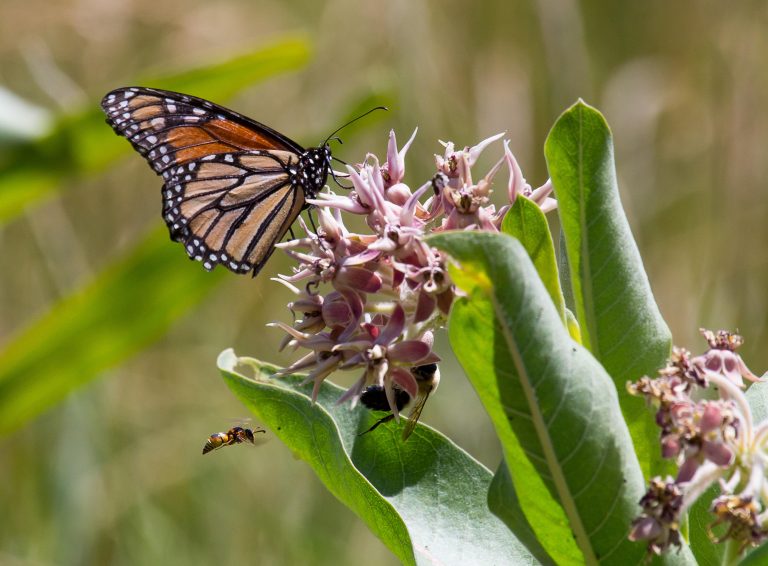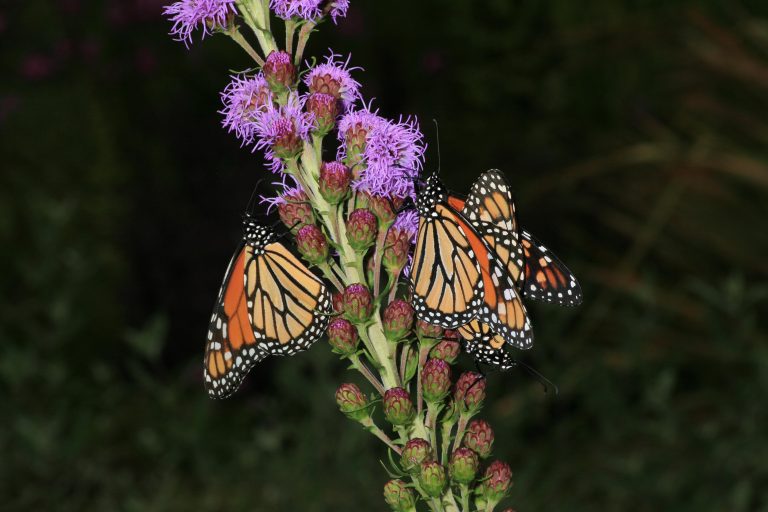The Xerces Society has been a proponent of monarch butterfly conservation for decades. In the early 1980s, Xerces founder Robert Michael Pyle and Lincoln Brower worked to list the monarch migration as an endangered phenomenon with the IUCN, and the Society’s first employee was hired to conserve California overwintering sites at that time. In the last two years we’ve seen a remarkable increase of interest in monarch conservation. Two things in particular spurred this: the 2014 petition to list the monarch butterfly under the Endangered Species Act (submitted by the Xerces Society and partners) and the national pollinator strategy released by the White House, which has led to a policy that encourages all federal agencies to take action for pollinators — including monarch butterflies.
We have been able to draw on decades of experience in monarch conservation to contribute a rigorous scientific approach as well as expertise in habitat restoration, management, and conservation education to better understand the best approaches to recover monarchs. We have provided guidance, technical support, and pollinator expertise to federal agencies such as the Natural Resources Conservation Service, U.S. Forest Service, U.S. Fish and Wildlife Service, U.S. Geological Survey, National Park Service, and the U.S. State Department, and have worked under contract with the Federal Highways Administration to conserve monarch butterflies. Through our involvement in the Federal Monarch Butterfly High Level Working Group, the National and Tri-National Monarch Science Partnership, and the Monarch Joint Venture, we are advancing the science and practice of monarch conservation, and shaping state, national, and international monarch conservation priorities.

Benefiting more than just monarchs
Monarchs are a flagship species, allowing us to push for habitat improvements on farms, natural areas, and in urban landscapes that will benefit many species beyond monarchs. Areas restored, managed, or maintained for monarchs also benefits native bees and other pollinators as well as other beneficial insects, birds, and wildlife.
We have restored and protected tens of thousands of acres for the monarch butterfly. With the precipitous decline in its populations — over 80% — we have ramped up our efforts to protect, manage, and restore monarch habitat in all landscapes from farmland to wildlife refuges and now have multiple staff members working on monarch conservation across the United States.
Demonstrating the possibilities
Working with the Tallgrass Prairie Center and the Monarch Joint Venture, we installed a series of monarch habitat demonstration sites in one of the regions that needs it most: the agricultural Midwest. Plots of quality habitat for monarchs were created on four organic farms in Minnesota and Wisconsin, providing concrete examples that pollinator conservation is an achievable, successful, and beneficial activity in which farmers can engage. Field days at each of these farms not only motivates farmers to take action for monarchs and other pollinators, but also gives participants the technical information needed to make their future habitat installations succeed.
Also, knowing we cannot restore habitat without milkweed and high quality nectar plants, Xerces is working with the seed industry to better understand the challenges with production of milkweed and other pollinator plants. By working with seed producers, we hope to bring more milkweed to market at lower costs.

Informing monarch conservation efforts
The U.S. Fish and Wildlife Service is working to restore and manage 100,000 acres on and around national wildlife refuges. To ensure that these restoration projects endure for the long term, our staff is providing training to U.S. Fish and Wildlife Service (USFWS) staff on restoration methods via webinars and workshops.
We helped the NRCS develop the Monarch Habitat Development Project which will provide 2 million in cost share dollars to farmers that implement monarch habitat restoration projects in ten states in the core of the monarch’s migration corridor. Prior to the launch of this new NRCS initiative, we conducted two webinars for NRCS field office staff. Additional webinars introduced over 300 NRCS field staff to region-specific monarch habitat evaluation tools, which the Xerces Society also helped to develop.
Monarchs in the West
The Xerces Society’s Western Monarch Thanksgiving Count is the longest running effort to monitor overwintering monarchs in California. The count spans 16 counties along the California coast and happens during a three-week period centered on Thanksgiving. This year, more than 100 volunteers participated and 187 sites were surveyed. From this effort, we know that the western monarch population has undergone a 74% decline over the past 20 years.
We are also involved in evaluating the health of the overwintering sites in California and are working with land managers and site owners to plan and implement restoration activities. Earlier this year, we conducted a workshop to train managers of overwintering sites who wish to restore habitat.
Because the Great Basin and Intermountain West host many important breeding areas for the western monarch population, we are conducting outreach to land managers in these regions, providing training in conservation methods that benefit monarchs in Idaho, Washington, Nevada, and California, and working with the U.S. Fish and Wildlife Service and other partners to undertake West-wide surveys for milkweeds.

National and international reach
We are working with agency staff at the highest levels in Mexico, Canada, and the United States to ensure the monarchs are recovered. Last December, we participated in the White House Pollinator Transportation Summit to discuss how roadside could be better managed to provide habitat for all monarchs and other pollinators. In April of this year, we were the only nonprofit to present on monarchs at the XXI Meeting of the Canada/Mexico/U.S. Trilateral Committee for Wildlife and Ecosystem Conservation and Management in Ottawa, Canada. We are also engaged in the Tri-National Monarch Science Partnership which is trying to better understand the causes of decline and the solutions to these problems. We have been able to shape the discussions so that all aspects of monarch conservation are considered — including how best to restore and manage habitat and how the large-scale use of toxic insecticides may be impacting monarchs.
We are also working with the North America’s Commission for Environmental Cooperation (CEC) to compiled information on best practices, incentive programs, and tools that will help private landowners adopt conservation practices for the monarch butterfly throughout North America. This compendium of information will demonstrate existing effective strategies for monarch habitat restoration and management at the regional, national, and continental scales, and illustrate how monarch-friendly practices can be adopted and landscapes managed over the long term.
The challenge to recover monarch populations is very large which is why the Xerces is working at multiple scales beyond national borders. Although the challenge is great, the effort to protect the monarch butterflies is growing exponentially. With decades of experience working on these issues we hope we can guide these new efforts so that they can be as effective as possible.
For a full report on our monarch conservation efforts, click here to read our July 2016 Monarch Update



